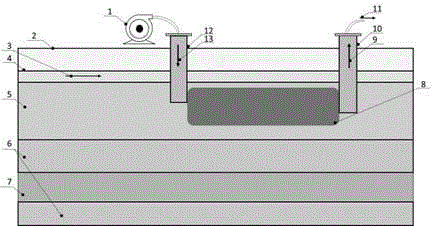Method for remedying halohydrocarbon contaminated site through combination of chemical leaching and microorganisms
A chemical rinsing and microbial technology, applied in the field of restoration of halocarbon-contaminated sites, can solve problems such as difficulty in ensuring the accurate arrival of chemical reagents, microbial toxicity, and short residence time of chemical reagents, and achieve complete restoration of halocarbon pollutants , the effect of complete repair
- Summary
- Abstract
- Description
- Claims
- Application Information
AI Technical Summary
Problems solved by technology
Method used
Image
Examples
Embodiment Construction
[0012] 1) Choose rhamnose as the biosurfactant in the prepared eluent, and choose glycerol as the alcohol in the eluent, in which rhamnose, glycerol and water account for the proportion of the whole eluent mass 25%, 25% and 50% respectively;
[0013] 2) The site survey found that the selected target polluted sites mainly contain chlorinated hydrocarbon DNAPLs, the pollution source area 8 containing DNAPLs is 4-7 meters underground, the groundwater level line 4 is 2.5 meters underground, and the groundwater flow direction 3 is from west to east direction, the hydrogeology of the contaminated site mainly includes an unsaturated layer 0.8 meters thick below the groundwater level, a free aquifer 5 with a depth of 3.3 meters to 8 meters above the ground, an isolation layer 6 under the free aquifer, and an isolation layer under the isolation layer. Confined aquifer 7, there is another layer of isolation layer under the confined aquifer 7, such as figure 1 shown;
[0014] 3) The me...
PUM
 Login to View More
Login to View More Abstract
Description
Claims
Application Information
 Login to View More
Login to View More - R&D
- Intellectual Property
- Life Sciences
- Materials
- Tech Scout
- Unparalleled Data Quality
- Higher Quality Content
- 60% Fewer Hallucinations
Browse by: Latest US Patents, China's latest patents, Technical Efficacy Thesaurus, Application Domain, Technology Topic, Popular Technical Reports.
© 2025 PatSnap. All rights reserved.Legal|Privacy policy|Modern Slavery Act Transparency Statement|Sitemap|About US| Contact US: help@patsnap.com

